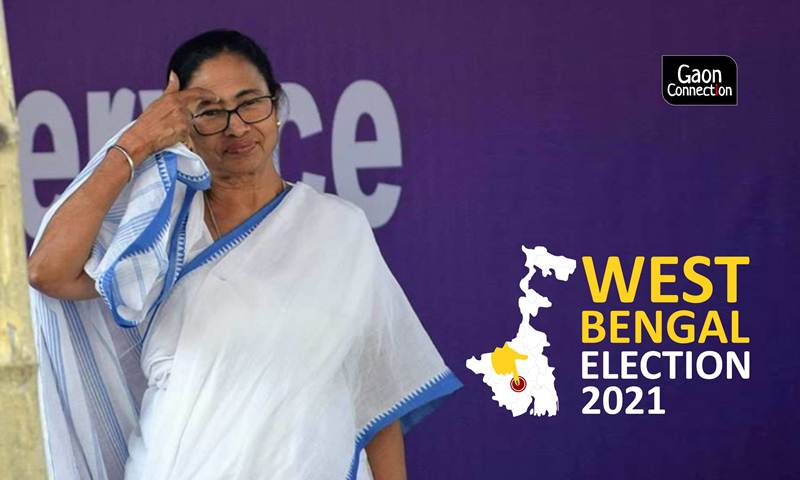Nandigram, West Bengal
As the voting is underway in Nandigram for the second phase of West Bengal assembly elections, the contest for this particular seat is being closely observed by pundits, voters and politicians alike. West Bengal Chief Minister Mamata Banerjee is contesting the polls from Nandigram itself and is electrorally challenged by her former lieutenant Suvendu Adhikari who recently crossed over to the BJP.
The two seats of Nandigram and Singur have historically proven to be decisive in changing the course of politics in the state. The Nandigram killings and the Singur movement were important factors that led to the collapse of the Left government in 2011. The Left had ruled West Bengal for a stretch of 34 years prior to its diminished base amongst the peasants and workers of seats like Singur and Nandigram.
Also Read: Battle for Bengal: Scrapped Tata Nano project, Singur’s farmers and uncultivable land
The origins of the Nandigram incident date back to 2006 when tired of the slow economic development in the state, the CPI(M) government decided to create a Special Economic Zone (SEZ) and made efforts to acquire lands for the same. The SEZ plan was part of a deal with the Indonesian firm Salim Group which wanted to establish its industries in the region. Banerjee, who led the Trinamool Congress (TMC) in the opposition, protested against the land acquisition of the farmers.
Also Read: The unmarried girl and other stories from a village in election-bound West Bengal
The issue became a political hot potato between the ruling CPI(M) and TMC.
In 2007, 14 villagers were killed in police firing who were demonstrating against the government’s proposed land acquisition for a chemical hub of Indonesia’s company.
Also Read: Cheated twice, dejected Bardhaman farmers want their land back
The Nandigram violence gave rise to TMC’s Maa, Mati, Manush (Mother, Motherland and People) slogan which was exploited in the election campaigns. Hence, Nandigram ensured the inception of Banerjee’s image as a pro-farmer political leader.
Similar is the case of Singur where Banerjee protested against the land acquisition for Tata’s Nano Automobile manufacturing plant.
Meanwhile, Banerjee is presently in Nandigram where she is facing a battle of prestige with BJP’s candidate Adikari.
As the voting is underway in Nandigram for the second phase of West Bengal assembly elections, the contest for this particular seat is being closely observed by pundits, voters and politicians alike. West Bengal Chief Minister Mamata Banerjee is contesting the polls from Nandigram itself and is electrorally challenged by her former lieutenant Suvendu Adhikari who recently crossed over to the BJP.
Also Read: West Bengal Election 2021: A shuttered Dunlop factory, an abandoned workforce, and politicking
The two seats of Nandigram and Singur have historically proven to be decisive in changing the course of politics in the state. The Nandigram killings and the Singur movement were important factors that led to the collapse of the Left government in 2011. The Left had ruled West Bengal for a stretch of 34 years prior to its diminished base amongst the peasants and workers of seats like Singur and Nandigram.
Also Read: Battle for Bengal: Scrapped Tata Nano project, Singur’s farmers and uncultivable land
The incident killings date back to 2006 when tired of the slow economic development in the state, the CPI(M) government decided to create a Special Economic Zone (SEZ) and made efforts to acquire lands for the same. The SEZ plan was part of a deal with the Indonesian firm Salim Group which wanted to establish its industries in the region. Banerjee, who led the Trinamool Congress (TMC) in the opposition, protested against the land acquisition of the farmers.
Also Read: The unmarried girl and other stories from a village in election-bound West Bengal
The issue became a political hot potato between the ruling CPI(M) and TMC.
In 2007, 14 villagers were killed in police firing who were demonstrating against the government’s proposed land acquisition for a chemical hub of Indonesia’s company.
Also Read: Cheated twice, dejected Bardhaman farmers want their land back
The Nandigram violence gave rise to TMC’s Maa, Mati, Manush (Mother, Motherland and People) slogan which was exploited in the election campaigns. Hence, Nandigram ensured the inception of Banerjee’s image as a pro-farmer political leader.
Similar is the case of Singur where Banerjee protested against the land acquisition for Tata’s Nano Automobile manufacturing plant.
Meanwhile, Banerjee is presently in Nandigram where she is facing a battle of prestige with BJP’s candidate Adikari.
Also Read: Marooned villages, cracked fields, saline water… The Sundarbans is a hot potato during elections
The polling in the second phase of West Bengal Assembly elections remained significantly high. At 4 pm, the state has registered 71.07% voter turnout. Although news agencies reported that the situation is tense in a few areas with a few skirmishes, tight security prevails in all 30 constituencies which went to polls.
Also Read: West Bengal Election 2021: A shuttered Dunlop factory, an abandoned workforce, and politicking



















